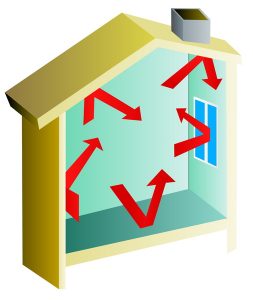 There are many ways you can improve your home’s indoor air quality and its ventilation. One of the most useful is the installation of an energy recovery ventilator (ERV) or heat recovery ventilator (HRV), devices which allow fresh air into your house without it drastically changing the indoor temperatures and placing more stress on the AC or heater.
There are many ways you can improve your home’s indoor air quality and its ventilation. One of the most useful is the installation of an energy recovery ventilator (ERV) or heat recovery ventilator (HRV), devices which allow fresh air into your house without it drastically changing the indoor temperatures and placing more stress on the AC or heater.
We usually talk about energy and heat recovery ventilators together, but they aren’t the exact same device. When people are looking for better home ventilation, they’re often curious about what’s different between the two. We’ll explain ERV vs. HRV below.
The Basic Difference
The operation and purpose of ERVs and HRVs are almost identical. They both draw currents of fresh outdoor air into the ventilation system, and then use a current of stale indoor air to either pre-heat or pre-cool the fresh air. As the two currents of air pass through the device, heat moves from one to the other (so hot outdoor air loses heat and cools, cold outdoor air gains heat and warms up), and the stale air is sent outdoors and the fresh air indoors—already heated or cooled.
What’s different between ERVs and HRVs is the transfer of moisture. In an HRV the two currents run through separate chambers and heat transfers between them through a heat exchanger. There’s no movement of moisture. In an ERV, the currents contact each other, so moisture is transferred along with the heat. The bottom line: an ERV affects humidity levels and HRVs don’t.
Which Is the Best to Install?
Reading the above, you might think the ERV is the better option. High and low humidity are often problems during the year, and the ERV can help with improving indoor extremes.
But there’s no single answer to the question. ERVs and HRVs are used all around the country in almost equal amounts. HRVs are often considered better for places where low humidity in winter is a large concern, but high humidity in the summer isn’t. The ERV works better for when humidity swings through extremes during the year. The best way to make a choice between the two is to work with an indoor air quality specialist. You’ll need a specialist to handle the installation, so call on one early to help pick the ideal unit.
Either Way, HRVS and ERVs Are Great!
The advantages of heating and energy recovery ventilators are terrific, and we think they’re among the best indoor air quality solutions in Staten Island, NY. Think of them as like throwing open the windows of your house to the outdoors without dealing with the heat or cold coming in. You get a fresh breeze while also allowing your furnace or air conditioner to work as normal. The two systems recover around 80% of the energy the HVAC system uses to heat or cool the air and uses it on the incoming air—that’s a lot of energy savings.
Bob Mims Heating & Air Conditioning has served Staten Island’s Heating and A/C needs since 1955. Schedule indoor air quality improvements with us today.

